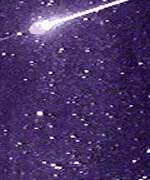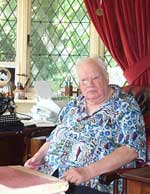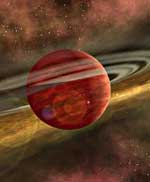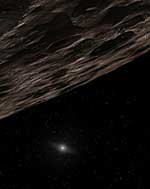
Image credit: NASA
Monday, November 15 – On this day in 1738, William Herschel is born in Hanover, Germany. He left for England at age 19 to work as a music teacher, but ended up devoting all his spare time to mathematics and astronomy. Building his own telescope, in 1774 he enlisted the aid of his sister Caroline (also an astronomer) and began exploring the cosmos. In 1781 he discovered a new planet which he named Georgium Sidus for the king, but we more commonly know it as Uranus. The king then appointed Herschel as his private astronomer allowing him to devote all of his time to study. He built a 48 inch (1.22 meter) aperture scope at Slough, which enabled his discovery of two moons belonging to Uranus and the sixth and seventh moons of Saturn. He also studied rotation of the planets – as well as the motion of double stars, cataloging more than 800 of them. Herschel’s studies of nebulae increased the numbers of the observed from 100 to 2500 and was the first to speculate they were comprised of stars. Knighted in 1816, Sir William Herschel is considered the founder of sidereal astronomy. Happy Birthday!
As darkness falls, the tender crescent Moon appears low in the southwest among the stars of teapot-shaped constellation, Sagittarius. Mercury may be visible to the west and much lower on the horizon.
Tonight this three-day old Moon will provide a splendid view of crater Cleomides. It’s a very old crater, and as a “Class Five” is thought to have experienced different degrees of lava flooding, or perhaps filled with ashes, during its formation causing it to be more shallow than its original depth. For those with stable skies and instruments capable of supporting high power, Cleomides also has a fine and beautiful rima that extends approximately 30 km across its northern floor.
Since the Moon will be well out of the way at an early hour, why not take the opportunity tonight to study a globular cluster? Located in the eastern part of the constellation of Capricornus, the M30 is about six degrees south of bright star Gamma and located in the field of view with 41 Capricorni. Found in August of 1764 by Charles Messier, most binoculars from a dark sky location will have little problem distinguishing this small globular cluster. Telescopes will enjoy the M30 for its bright beauty and fine resolving powers with larger instruments. At approximately 26,000 light years away, the core of M30 is extremely dense and believed to have suffered a core collapse, making its linear radius span approximately 139 light years. Any stars beyond that distance would escape the influence of the globular structure simply because of the Milky Way Galaxy’s tidal gravitational forces. As an added treat as you will discover 41 Capricorni (in the same field of view) is a double star!
Tuesday, November 16 – Venus will hold court 4 degrees north of the bright blue star, Spica, in the constellation of Virgo in the predawn eastern sky. Appearing with it will be Jupiter and faint red Mars forming nearly a straight line across the east-southeast. Spica will be above and to the right of Mars.
Tonight the four-day old Moon will provide the opportunity to note a very changeable and eventually bright feature on the lunar surface – Proclus. At around 28 km (18 miles) in diameter and 2400 meters (11,900 feet) deep, crater Proclus will appear on the terminator on the west mountainous border of Mare Crisium. Tonight Proclus will seem to be about 2/3 black, but 1/3 of the exposed crater will be exceptionally brilliant. The reason for this is that crater Proclus has an albedo, or surface reflectivity of about 16%, which is an unusually high value for a lunar feature. Watch this area over the next few nights as two rays from the crater will widen and lengthen, extending approximately 322 km (200 miles) to both the north and south.
Take the opportunity tonight to study an extremely fine, colorful star system that is wonderful in binoculars and outstanding in the telescope. Located northeast of previous study star Deneb, (and visible to the naked-eye) Omicron 1 Cygni (aka 31 Cygni) is a premier object. Its blue secondary stars contrast wonderfully with the brilliant gold of the primary. Omicron is a widely “spaced” system providing easy resolution with the most modest of optical aids. You’ll like this one!
November 17 – 19 – The annual Leonid meteor shower will be underway, but for those of you seeking a definitive date and time, it doesn’t always happen. The degree of the meteor shower itself belongs to the debris shed by comet 55/P Tempel-Tuttle as it passes our Sun in its 33.2 year orbital period. Although it was once assumed that we would merely add around 33 years to each observed “shower”, we later came to realize that the debris formed a cloud that lagged behind the comet and dispersed irregularly. With each successive pass of Tempel-Tuttle, new filaments of debris were left in space as well as the old ones, creating different “streams” that the orbiting Earth would cross through at varying times making blanket predictions unreliable at best.
Each year during November, we pass through these filaments – both old and new – and the chances of impacting a particular “stream” from any one particular year of Tempel-Tuttle’s orbit becomes a matter of mathematical equations. We know when it passed… We know where it passed… But will we encounter it and to what degree? Traditional dates for the peak of the Leonid Meteor shower occur as early as the morning of November 17 and as late as November 19, but what about this year? On November 8, the Earth passed through an ancient stream shed in 1001. Predictions ran high for viewers in Asia, but the results turned out to be a dud. There is no doubt that we crossed through that stream, but its probability of dissipation is incalculable. Debris trails left by the comet in 1333 and 1733 look the most promising this year. For November 19, Jeremie Vaubaillon, Esko Lyytinen, Markku Nissinen, and David Asher predict that U.S. observers will be favoured as we cross the trail at around 06:42 UT. Fall rates are not incredible (about 10 per hour) but observers in Asia are far more favoured as we encounter the second stream left in 1733 at around 21:49 UT. The predicted fall rate for this one jumps to a respectable 65 per hour.
We may never know precisely where and when the Leonids might strike, but we do know that a good time to look for this activity is well before dawn on November 17, 18 and 19th. With the Moon out of the way long before the radiant constellation of Leo rises, the chances are good of spotting one of the offspring of periodic comet Tempel-Tuttle. Your chances increase significantly by traveling a dark sky location, but remember to dress warmly and provide for your viewing comfort. If it is cloudy? Remember to try the simple trick of tuning an FM radio receiver to the lowest frequency that does not receive a clear signal and “listen” for the blips, beeps and bongs that signify meteor scatter!
Wednesday, November 17 – According to tradition, the peak of the Leonid meteor shower will occur this morning in the predawn hours. Since you have read the above explanation, you realize that we may not pass through the “stream” at this time and we just might! All predictions indicate a low level of activity – around 15 to 35 per hour – but if skies are clear? I’ll see you out there!
On this day in 1970, long running Soviet mission Luna 17 successfully landed on the Moon. Its Lunokhod 1 rover became the first wheeled vehicle on the Moon. Lunokhod was designed to function three lunar days but actually operated for eleven. The machinations of Lunokhod officially stopped on October 4, 1971, the anniversary of Sputnik 1. Lunokhod had traversed 10,540 meters, transmitted more than 20,000 television pictures, over 200 television panoramas and performed more than 500 lunar soil tests. Spaseba!
Tonight will also be a perfect opportunity to study crater Theophilus in either binoculars or telescopes. Located on the terminator and bordered on the northern edge by Mare Nectaris and the south by Mare Tranquillitatus, Theophilus has an average diameter of 105 km (65 miles) and contains a wonderful multiple mountain peaked center. This particular crater is unusual in the sense that the floor is parabolic. The interior may be dark, but you will see a bright point of light that is the summit of its huge central peak.
Using the Moon as our guide tonight, why not try to find Neptune once again? At 21h Neptune will be located just 5 degrees north or the Moon!
Thursday, November 18 – Be sure to get up extra early today in hopes of catching the Leonid meteor shower! (see above for predictions.) In the darkness before dawn, blue Spica appars to the right of bright Venus. Mars is below and Jupiter above. Mars will occult TYC 5561-00614-1 (11.7 Magnitude Star) and Mercury will occult TYC 6815-04687-1 (9.1 Magnitude Star). See link for times and areas.
Tonight’s outstanding lunar feature will be a pair of craters that you cannot miss – Aristotle and Eudoxus. Located to the north, this pair of Class 1 craters will be highly prominent in both binoculars and telescopes. The northernmost, Aristotle was named for the great philosopher and has an expanse of approximately 87 km. Its deep and rugged walls show a wealth of detail for high power and two small interior peaks. Companion crater to the south, Eudoxus, spans 67 km and offers up equally rugged details.
Although skies will be bright, you can still do a little bit of binocular study on a very fine asterism known as the “Coathanger”. The proper name is Collider 399, but the pattern of stars wonderfully resembles a coat hanger. It is easy located in the constellation of Vulpecula. Find previous study star, Albireo once again and the relatively bright star south of that is Alpha Vulpeculae. Just aim your binoculars there and enjoy the smiles it brings!
Friday, November 19 – Are the predawn hours going to be the peak of the Leonid meteor shower for 2004? We just don’t know for certain, but if skies are clear, I plan on observing again this morning! (Let’s see just how accurate those predications are…)
The First Quarter Moon occurs at 12:50 UT and Algol will reach minima at 07:22 UT today. The Moon will reach its maximum libration tonight of 8.4 degrees, permitting those of you interested a view of Gauss and Hahn on the northeastern limb. On this day in 1969, Apollo 12, the second manned mission to the Moon, lands safely in the Oceanus Procellarum (Ocean of Storms). Why not celebrate by observing our nearest astronomical neighbor tonight?
For binoculars and telescopes, the Moon will provide a piece of scenic history as we take an in-depth look at crater Albategnius. This huge, hexagonal mountain walled plain will appear near the terminator about one third the way north from the south limb. This 81 mile (136 km) wide crater is approximately 14,400 feet deep and the west wall will cast a black shadow on the dark floor. Albategnius is very ancient formation, filled partially with lava at one point in its development, and is home to several wall craters like Klein (which will appear telescopically on its southwest wall). Albategnius holds more than just the distinction of being a prominent crater tonight – it holds a place in history. On May 9, 1962 Louis Smullin and Giorgio Fiocco of the Massachusetts Institute of technology aimed a red laser beam toward the lunar surface and Albategnius became the first lunar object to be illuminated and detected by a laser from Earth!
On March 24, 1965 Ranger 9 took this “snapshot” of Albategnius (lower right) from an altitude of approximately 2500 km. Companion craters in the image are Pltomaeus and Alphonsus, which will be revealed tomorrow night. The Ranger 9 was designed by NASA for one purpose – to achieve a lunar impact trajectory and to send back high-resolution photographs and high-quality video images of the lunar surface. It carried no other scientific experiments, and its only destiny was to take pictures right up to the moment of final impact. It is interesting to note that Ranger 9 slammed into Alphonsus approximately 18.5 minutes after this photo was taken. They called that… A “hard landing.”
Tonight would also be a great time to re-locate Uranus. It’s only 4.1 degrees north of the Moon!
Saturday, November 20 – Today is Edwin Hubble’s 115th birthday! Born in 1889, U.S. astronomer Edwin Hubble, became the father of modern cosmology. His extensive list of accomplishments could fill pages, so please take the time to learn about one of the finest astronomers of our times.
Tonight’s featured lunar crater will be located on the south shore of Mare Ibrium right where the Apennine mountain range meets the terminator. Eratosthenes is a 37 mile (58 km) diameter and 12,300 foot deep unmistakable crater. Named after ancient mathematician, geographer and astronomer Eratosthenes, this splendid Class 1 crater will display a bright west wall and a black interior which hides its massive crater capped central mountain (3570 meters high!) tonight. Extending like a tail, a 50 mile long mountain ridge angles away to the southwest. As beautiful as Eratostenes appears tonight, it will fade away to total obscurity as the Moon becomes more full. See if you can spot it in five days!
After having looked at the Moon tonight, take the time out to view bright southern star – Formalhaut. Also known as “The Lonely One”, Alpha Pices Austrinis seems to sit in a rather empty area in the southern skies 23 light years away. At magnitude 1, this main sequence A3 giant is the southern-most visible star of its type to northern hemisphere viewers and it is the 18th brightest star in the sky. “The Lonely One” is about twice the diameter of our own Sun, but 14 times more luminous!
Sunday, November 21 – Mercury at greatest elongation east (22 degrees) of the Sun, appearing low in the southwestern sky after sunset, or try looking for it in the darkness just before dawn.
Tonight’s lunar feature can sometimes be spotted with only the naked eye. Located to the northern hemisphere of the Moon, the dark ellipse of crater Plato is unmistakable. Named after the famous philosopher, this Class 5 crater spans approximately 64 by 67 miles (101 km) but is a shallow 8000 feet deep. Plato’s floor is 2700 square miles of lava and has been studied for over 300 years. This crater has the distinction of being one of the only mountain-walled plains that doesn’t “disappear” as the Moon grows full! For those of you with very fine optics, or who wish a web cam challenge? Try finding Plato’s interior craterlets. Good luck!
For Southern Hemisphere viewers, tonight would be a wonderful opportunity to re-discover one of the finest double stars in the sky – Rigel Kentarus! Located low to the southwest, Alpha Centauri is the third brightest star in the sky, yet the most famous because it is the nearest star to our solar system at a distance of only 4.34 light years!
Until next week? Keep looking up! I wish you clear skies and light speed… ~Tammy Plotner





